These Korean Rice Bowls (Bibimbap) are loaded with fresh asparagus and marinated steak, and topped with a fried egg. An easy and oh-so-delicious recipe that will surely become a family favorite!

Korean Rice Bowls Are a Weeknight Dinner Your Family Will Love
Have you ever had bibimbap? Bibimbap is a Korean rice bowl. Korean rice bowls are really flexible and can be made in a lot of different ways, but the main idea is that you have a bowl of rice, topped with various ingredients like sauteed vegetables, steak or chicken, and almost always an egg. The egg is often a sunny-side-up egg, so that the yolk makes a “sauce.” So good!
My family loves, loves, loves this recipe, and in fact my boys request that I make it on a regular basis. I love it not only for the taste, but also because Korean rice bowls couldn’t be easier to toss together and clean up. All of which makes bibimbap a great weeknight dinner – although it is so popular around here, that I usually make them on Sundays when everyone is home. That way, no one misses out!
Korean Rice Bowls Are…
- Satisfying: No one will leave the table hungry with a hearty bowl of rice, veggies, steak, and eggs for dinner. Although this dish is light, it’s still very filling.
- Healthy: If you are tempted by takeout, make this instead! There’s no MSG or other questionable ingredients, and you can customize the sugar, salt, oil, and, well, everything else!
- Easy: If you can make a pot of rice and heat up a skillet, you can make this! It may seem a little involved, but once you make it you will see that the process is really simple and goes quickly. (Psst! Not too sure about the pot of rice? Check out my Perfect Rice tutorial and you’ll have the best rice ever!)
- Fun: Some dinners are just fun, and to me, Korean rice bowls are one of them. Like pizza and tacos, this is the kind of thing that people just seem to always be in the mood for, and it’s always a pleasant surprise when bibimbap is on the menu.
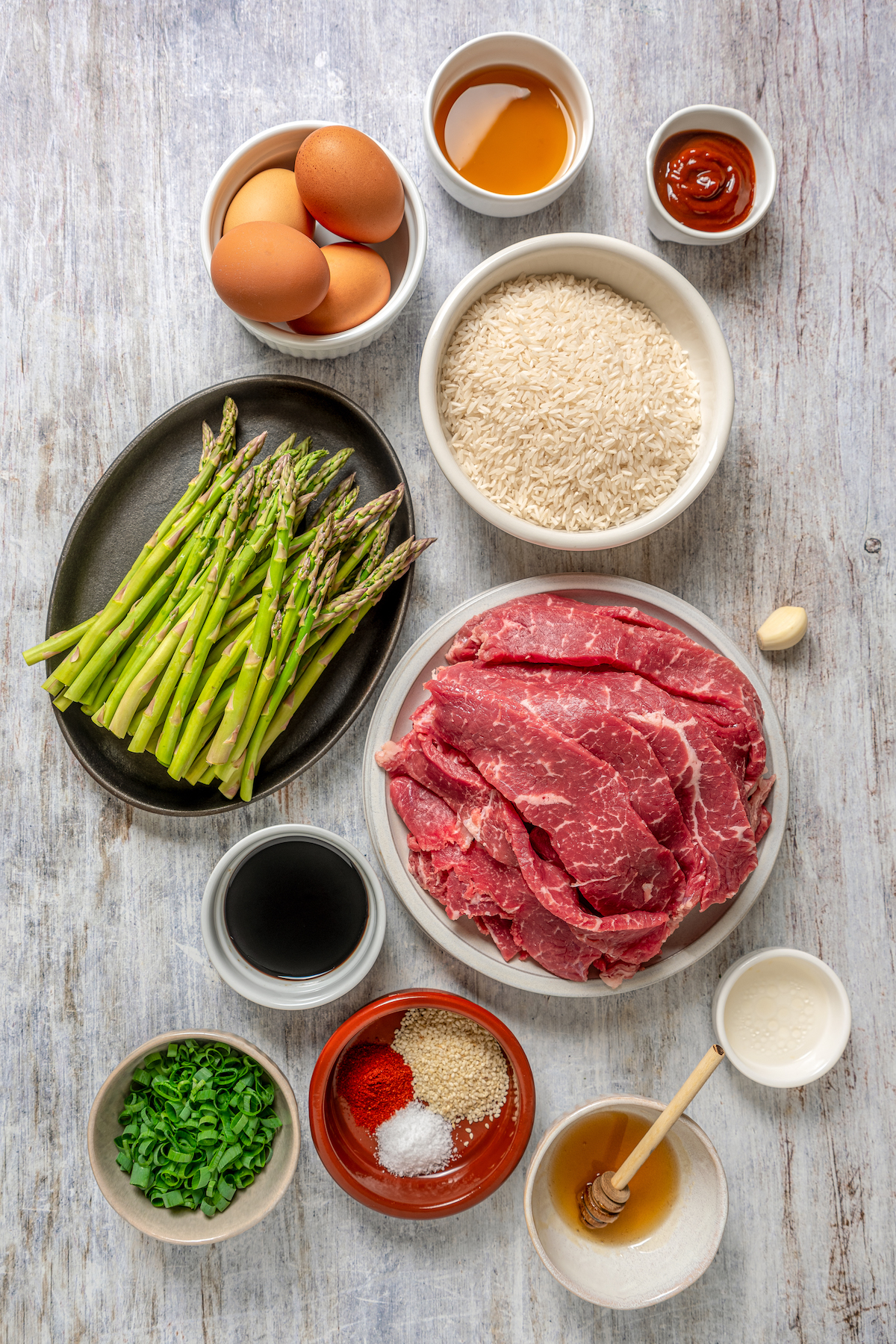
The Ingredients You’ll Need
To make this recipe, you will need ingredients for the steak, the spice blend, and the toppings (asparagus and fried eggs). You will also need your choice of rice.
Sesame Spice Blend
- Toasted Sesame Seeds: If you don’t have toasted sesame seeds, you can make your own – see the “Tips” section below.
- Fleur de Sel: Fleur de sel is a special form of sea salt with no impurities. If you don’t have it, you can substitute your favorite sea salt.
- Chile Powder: New Mexico chile powder, or Hungarian paprika.
Steak and Marinade
- Steak: Use a tender, steakhouse cut like New York strip, or flank steak. You’ll be slicing thinly against the grain so it will be tender either way.
- Soy Sauce: Or coconut aminos, or tamari.
- Sesame Oil: Divided – some for the marinade, some for the asparagus, and more for drizzling if you like.
- Green Onion: Finely chopped.
- Sugar: If you don’t want to use sugar, honey also tastes great in this marinade.
- Sake: Dry sherry or mirin will also work.
- Garlic: One minced garlic clove, or more if you like.
Toppings
- Asparagus: Choose slim asparagus spears, and trim or snap off the woody ends of the spears.
- Sesame Oil
- Eggs: I use four eggs for four servings, but feel free to make more.
- Rice: I like to use gluten free brown jasmine rice or basmati rice, but you could swap in cauliflower rice for a keto-friendly bowl.
- Sriracha: Optional, but tasty.

Is Korean Bibimbap Healthy?
In general, yes, this is a healthy dinner! It definitely depends on what you add to your bowl, of course, but the ingredients you see here are all wholesome, natural items that taste great and will make you feel great, too. Even better, you can flex these ingredients to suit your family’s tastes, dietary requirements, and pantry.

How to Make Korean Rice Bowls
Since this dish has a few different parts, you’ll be making them separately. Then, you will put them all together to create the perfect easy dinner. Here’s what that process looks like.
- Make the Sesame Spice. Using a mortar and pestle or a spice mill, process the sesame seeds, fleur de sel, and chile powder until about half of the sesame seeds are finely ground.
- Marinate the Steak. Cut the steak into ⅛ inch-thick slices, and set them aside. Combine the soy sauce, sesame oil, green onions, sugar, sake, and garlic in a zip-top bag, seal, and shake to mix. Drop the steak slices into the bag, seal, and shake to coat. Let this marinate for about 30 minutes (or overnight in the fridge, if you want to prepare it ahead!).


- Cook the Rice. Combine the rice and water in a medium saucepan. Bring to a boil, and then lower the heat. Cover the saucepan, and let the rice cook for about 20 minutes, or until soft and tender.
- Saute the Asparagus. Next, heat up a griddle or place 2 large, heavy skillets over medium-high heat. Toss the asparagus with the sesame oil, and saute until crisp-tender (about four minutes is usually what this takes, depending on the thickness). Set aside, sprinkle with sesame salt, and tent with foil to keep warm.
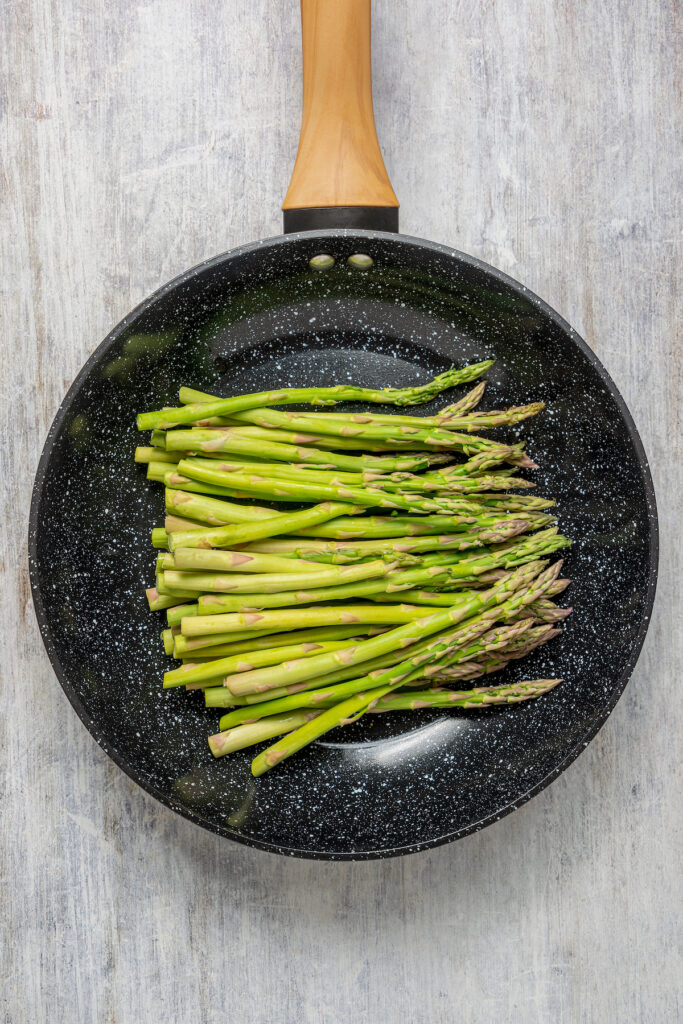
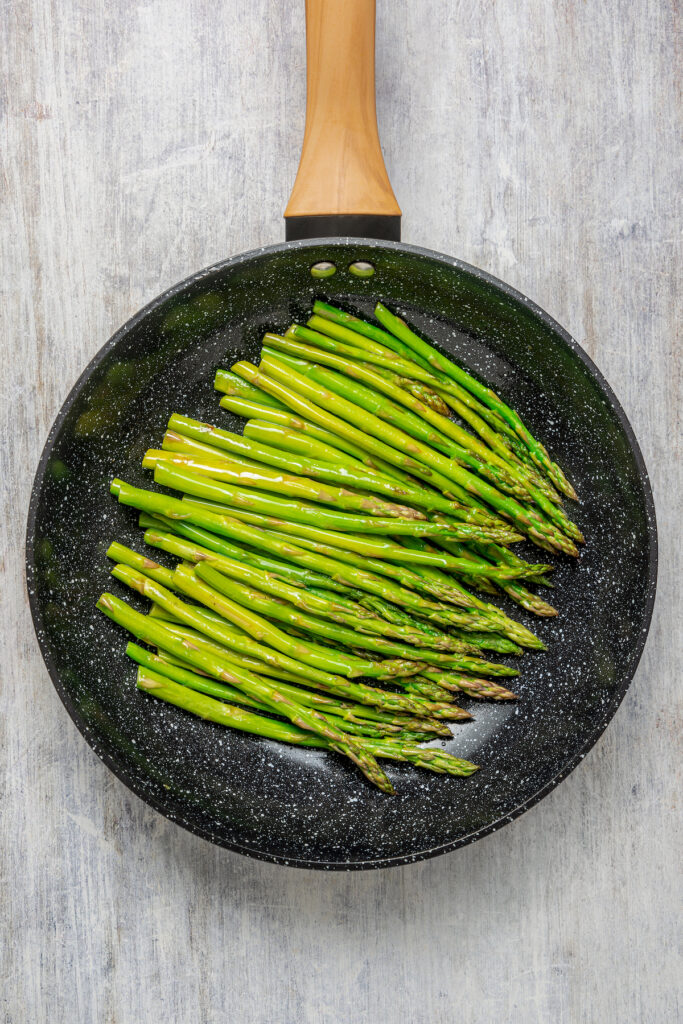
- Grill the Steak and Cook the Eggs. Finally, add the steak to your griddle, along with a few eggs. Cook the eggs sunny-side-up, and grill the steak until it is just browned, about one minute per side.
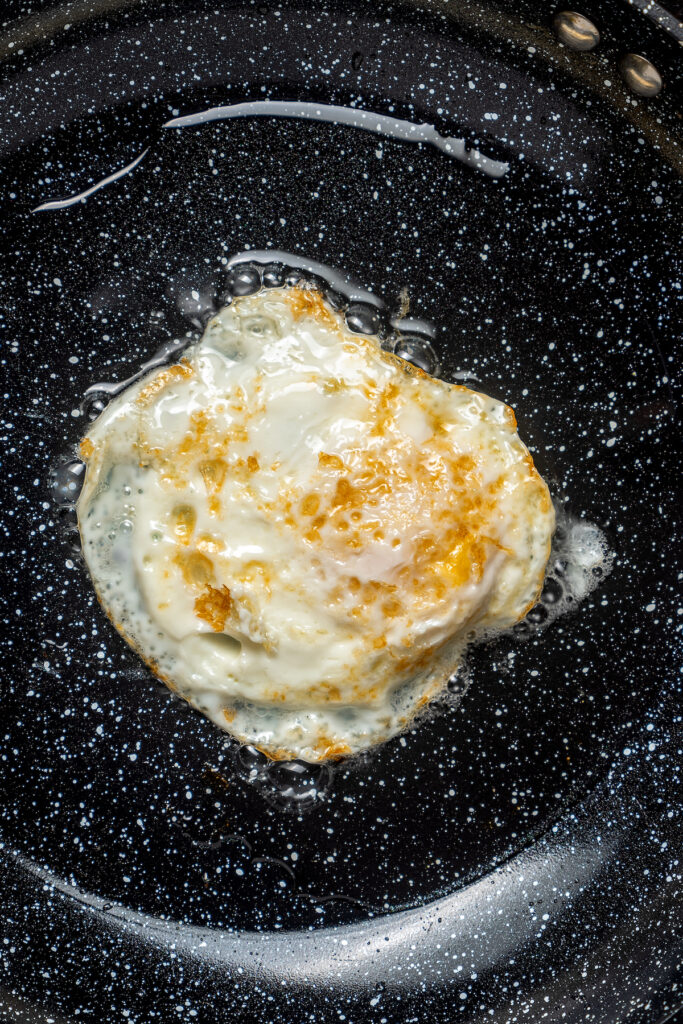

- Assemble the Korean Rice Bowls. Divide the warm rice between the bowls, and then top with beef, asparagus, a fried egg (or two), and a drizzle of sriracha sauce.

Tips and Tricks
Want to know more about making Korean rice bowls? Great! Here are some helpful tips for making this dish the best it can be. Read on, and enjoy!
- Sesame Seeds: If you are not using previously-toasted sesame seeds, you can toast regular sesame seeds in a small skillet over medium heat until they are golden brown, stirring often. This takes about 3 minutes.
- Toppings: To add some spicy kick, we like to add sriracha sauce to our bibimbap bowls. But you could also use gochujang, which is a Korean condiment that’s both spicy and deeply savory.
- Rice Options: To make this dish gluten free, you will need to make sure that all of your ingredients are gluten free, including the rice. We have been enjoying Lundberg Farms Organic California Brown Jasmine Rice lately.
- Spice Blend: If you do not have access to a spice mill or a mortar and pestle, use already-ground spices and just mix them together. I like to make extra and keep it in my pantry for seasoning veggies, eggs, and more.
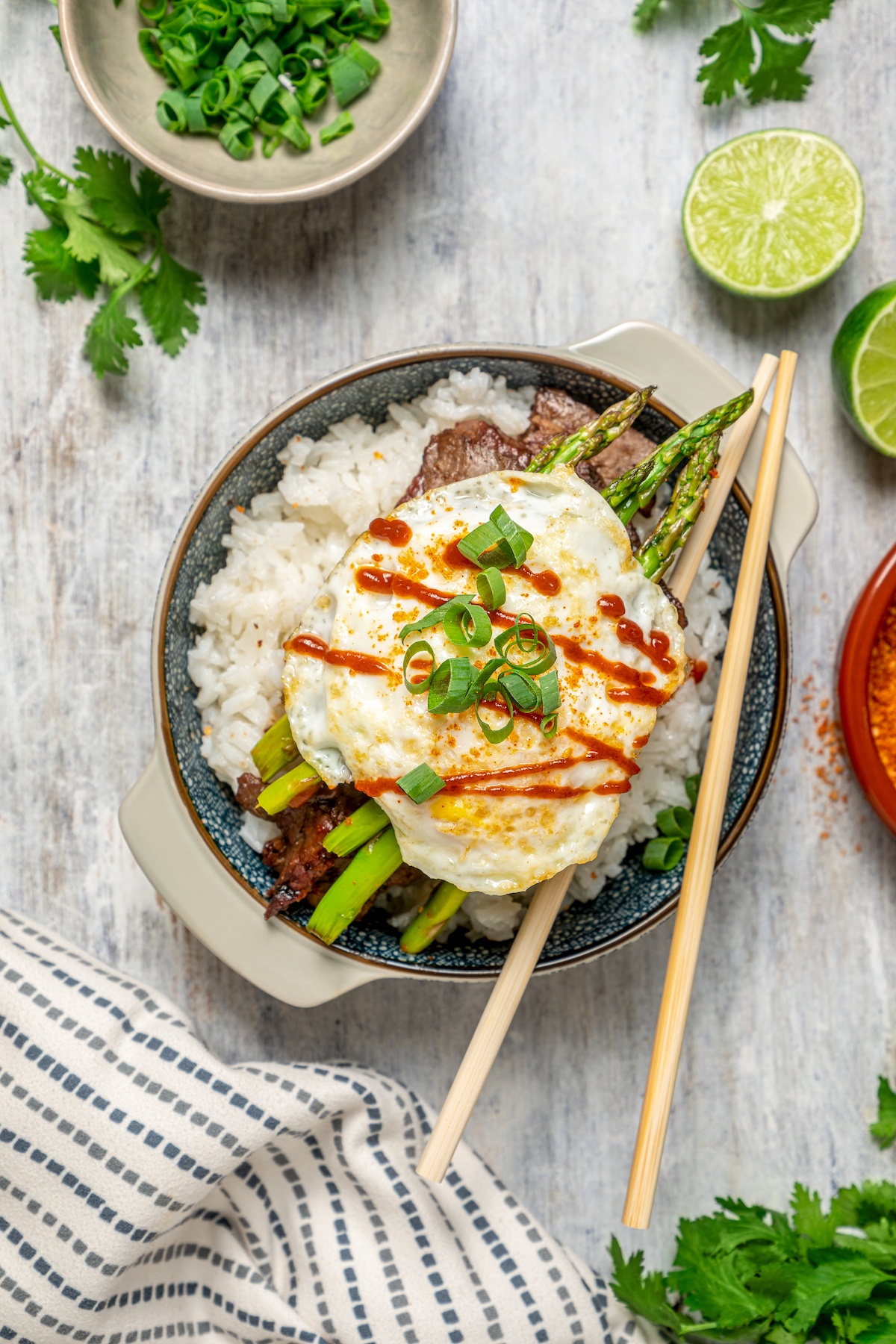
Serving Suggestions
What should you serve with Korean rice bowls? Honestly, this is a great one-dish meal, and I don’t usually add side dishes – they just aren’t necessary. However, if you want to add a couple of other dishes to the table, these recipes would work well:
- Soup: A light, brothy soup is always a great option to serve with Asian cuisine. This Immune Boosting Mushroom Soup is wholesome, tasty, and easy to make!
- Additional Veggies: When in doubt, add veggies! This Grilled Vegetable Plate would be perfect for adding fiber and taste to your dinner menu.
- Fruit: A serving of fruit, or a fruity appetizer like Apricots with Goat Cheese and Almond, is always a hit with this lightly spicy, super-savory dinner.
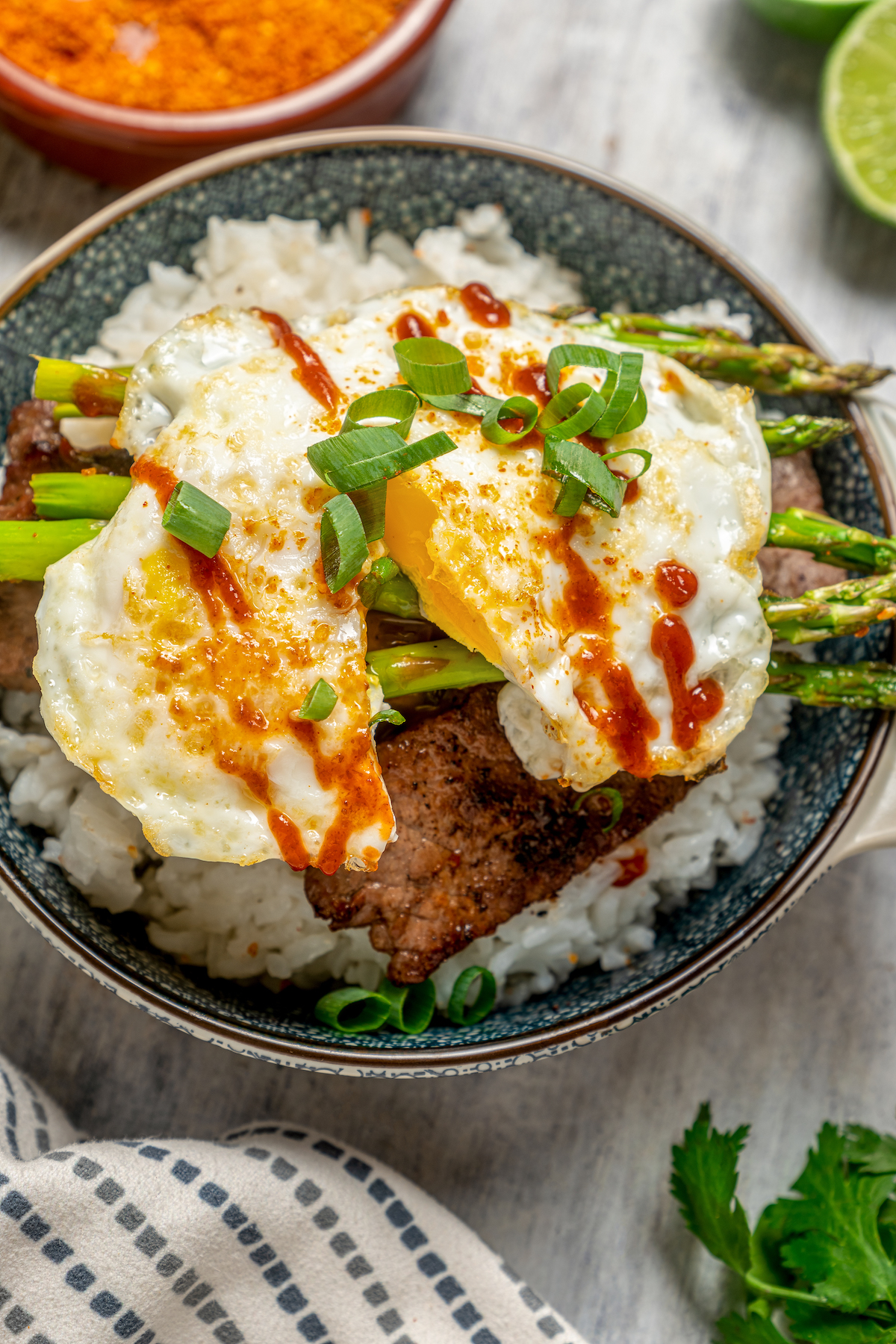
Storing and Reheating
Leftover Korean rice bowls can be stored in your refrigerator, tightly covered, for a day or two. I don’t recommend storing the sunny-side-up eggs along with the rest of the ingredients, because they typically do not store as well and can make the dish messy and unappealing.
Reheat Korean rice bowls in the microwave, or in a covered skillet over low heat (add a splash of water if the dish seems dry). Heat until the ingredients are piping hot, but don’t overcook or the steak will be tough.
Can I Freeze Korean Rice Bowls?
Some of the items in this recipe can be frozen: the steak, the veggies, and the rice! You can actually freeze all of these items for up to three months. Freeze them separately, in airtight containers or freezer bags, and thaw them in the fridge before reheating.
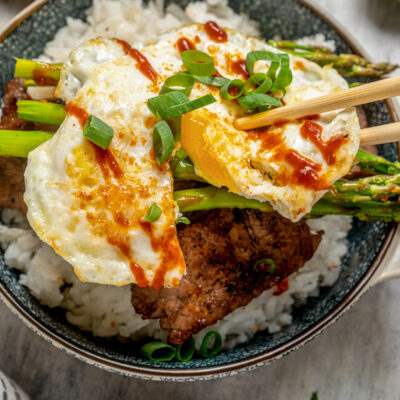
Korean Rice Bowls
Ingredients
Sesame Spice:
- 1 tablespoon toasted sesame seeds (you can toast your own, if you prefer)
- ¾ teaspoon fleur de sel
- ½ teaspoon New Mexico chile powder or Hungarian paprika
Marinade:
- 3 pounds New York strip steak or flank steak, trimmed if using strip
- ¼ cup soy sauce
- 3 tablespoons sesame oil divided
- 2 green onions finely chopped
- 2 tablespoons sugar or honey
- 1 tablespoon sake or dry Sherry
- 1 garlic clove minced
Additional:
- 1 ½ pounds asparagus spears slender, with woody ends trimmed
- 1 1/2 teaspoon sesame oil
- 4 large eggs
- 2 cups uncooked gluten free basmati rice or cauliflower rice
- Sriracha
Instructions
Sesame Spice:
- Grind sesame seeds, fleur de sel, and chile powder in a mortar with pestle or in a spice mill until about half of sesame seeds are finely ground. Return to same small bowl. (Can be made ahead.)
- Store in airtight container at room temperature. I make extra and have this on hand to pull out of the party when I make this dish. (If you do not have access to grinder use ground herbs and mix.)
Marinade:
- Cut steak crosswise into 1/8″ thick slices.
- Place soy sauce, 2 tablespoons sesame oil, green onions, sugar, sake, and garlic in Ziploc bag along with the steak.
- Let marinate at room temperature 30 minutes, tossing occasionally. (You can do this in the morning or night before and place in refrigerator.)
Cooking:
- Place rice and 3 cups of water in medium saucepan. Bring rice and water to boil, then lower heat to low and cover. Cook for 20 minutes.
- While rice is cooking heat griddle or 2 heavy large skillets over medium-high heat. Toss asparagus with sesame oil.
- Saute asparagus until crisp tender, about 4 minutes.
- Set aside on rimmed baking sheet and sprinkle sesame salt over.
- Tent with foil to keep warm.
- Working in batches, grill steak until just browned, about 1 minute per side.
- Transfer to a bowl; tent with foil to keep warm.
- Cook eggs sunny side up until whites are set but yolks are still runny 2 to 3 minutes.
- Divide warm rice among bowls.
- Top with beef, asparagus, fried egg or two and a drizzle of Sriracha Sauce.
Notes
- Sesame Seeds: If you are not using previously-toasted sesame seeds, you can toast regular sesame seeds in a small skillet over medium heat until they are golden brown, stirring often. This takes about 3 minutes.
- Toppings: To add some spicy kick, we like to add sriracha sauce to our bibimbap bowls. But you could also use gochujang, which is a Korean condiment that’s both spicy and deeply savory.
- Rice Options: To make this dish gluten free, you will need to make sure that all of your ingredients are gluten free, including the rice. We have been enjoying Lundberg Farms Organic California Brown Jasmine Rice lately.
- Spice Blend: If you do not have access to a spice mill or a mortar and pestle, use already-ground spices and just mix them together. I like to make extra, and keep it in my pantry for seasoning veggies, eggs, and more.
- Storing: Leftover Korean rice bowls can be stored in your refrigerator, tightly covered, for a day or two. I don’t recommend storing the sunny-side-up eggs along with the rest of the ingredients, because they typically do not store as well and can make the dish messy and unappealing.
- Freezing: Some of the items in this recipe can be frozen: the steak, the veggies, and the rice! You can actually freeze all of these items for up to three months. Freeze them separately, in airtight containers or freezer bags, and thaw in the fridge before reheating.



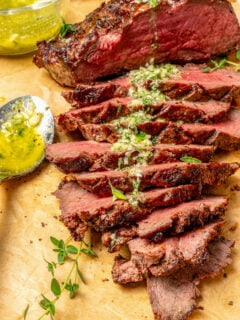



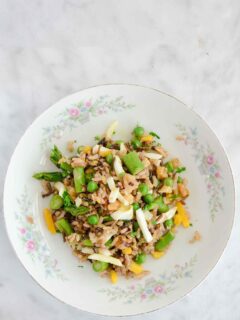

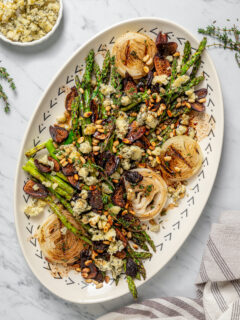
Oh man, I LOVE Korean rice bowls and this one looks so GOOD!
This looks beyond incredible, Amy! Love that perfectly cooked egg! I
Thank you, tt really is an awesome recipe Kelly.
Can’t wait to add this to my weeknight dinner to-make list!
I hope you enjoy it!
This dish is totally made for my hubby. He loves an egg on any type of rice dish. The marinade for the meat is making my stomach growl.
This looks amazing, Amy! Pretty much anything with sesame oil…
Love rice bowls as a quick dinner, these look delish!
Best dish ever thank you so much for the recipe!!!